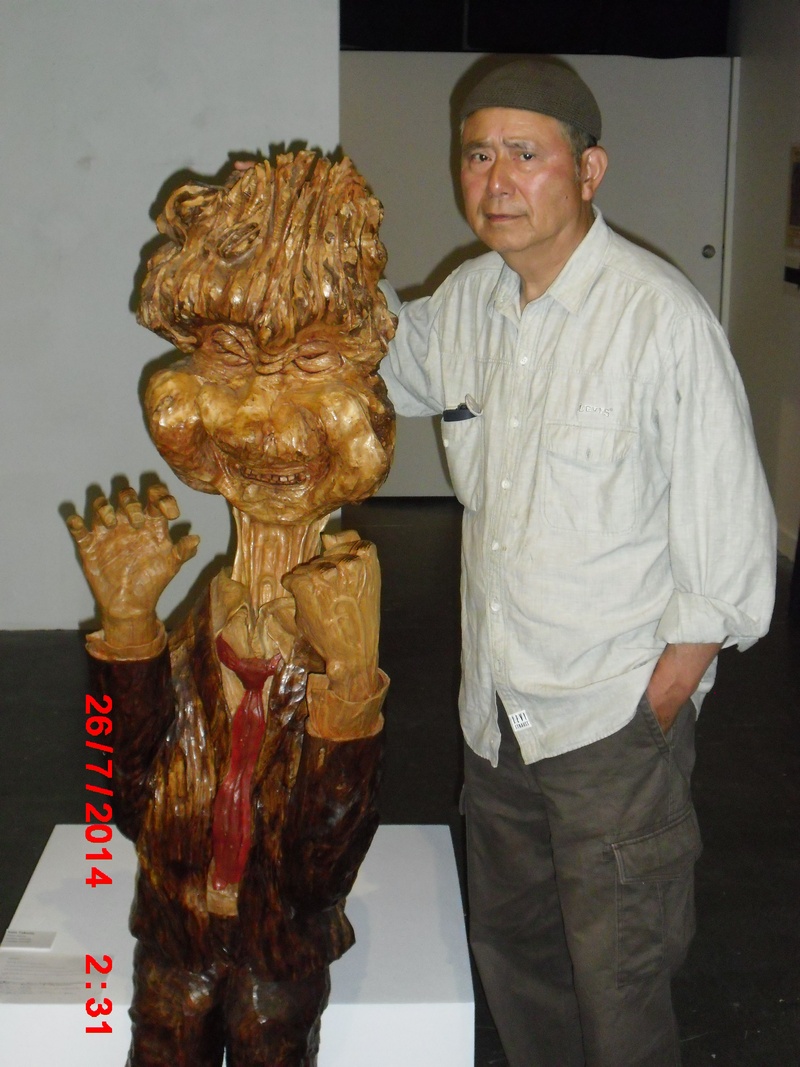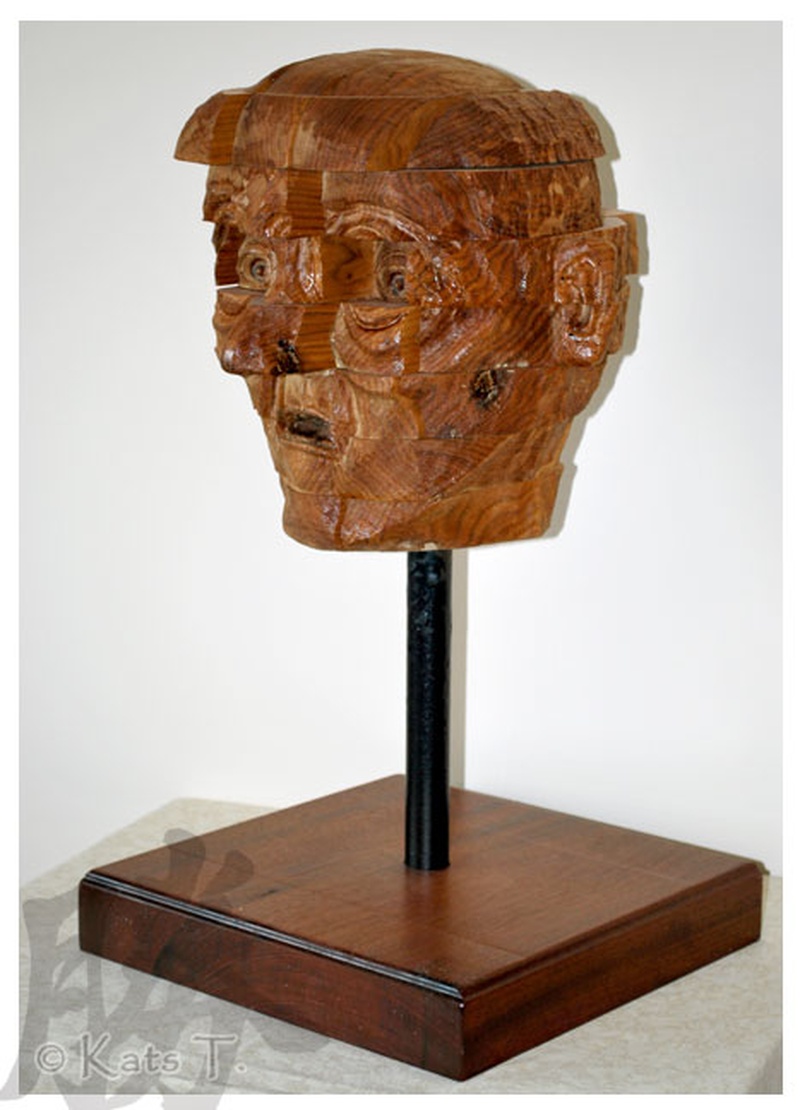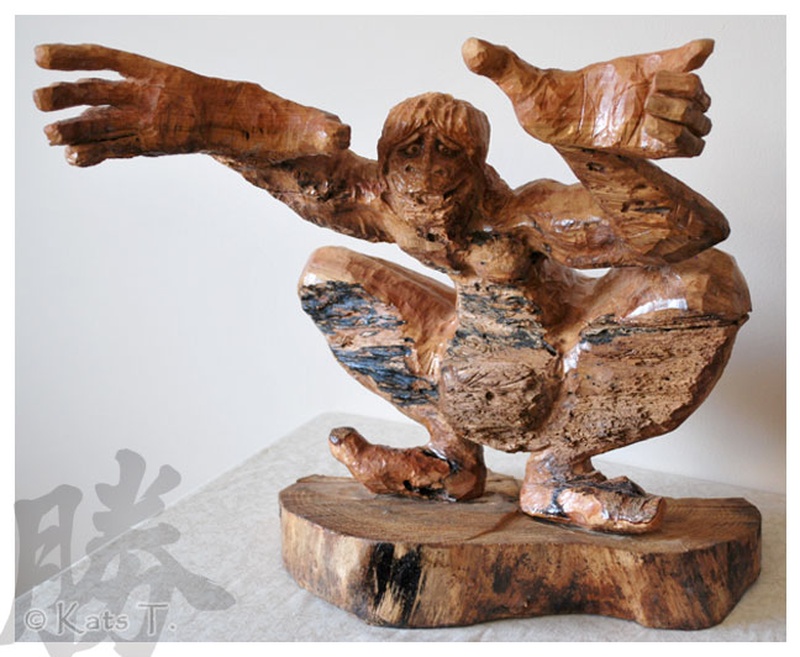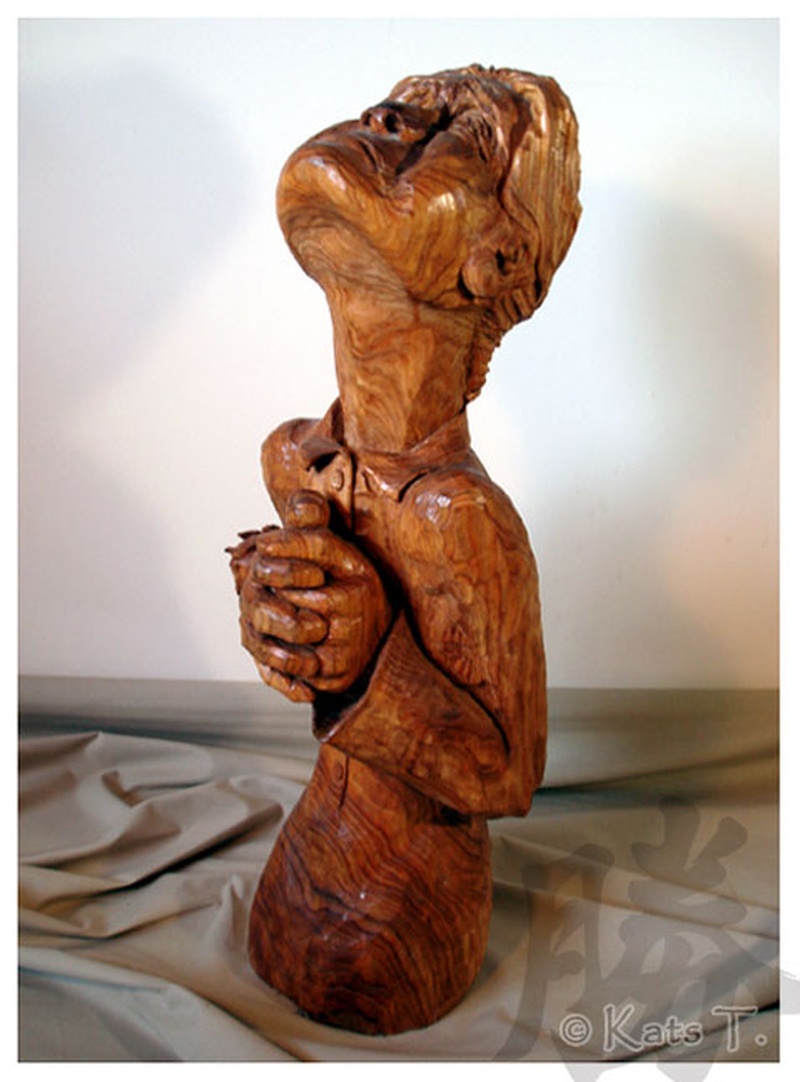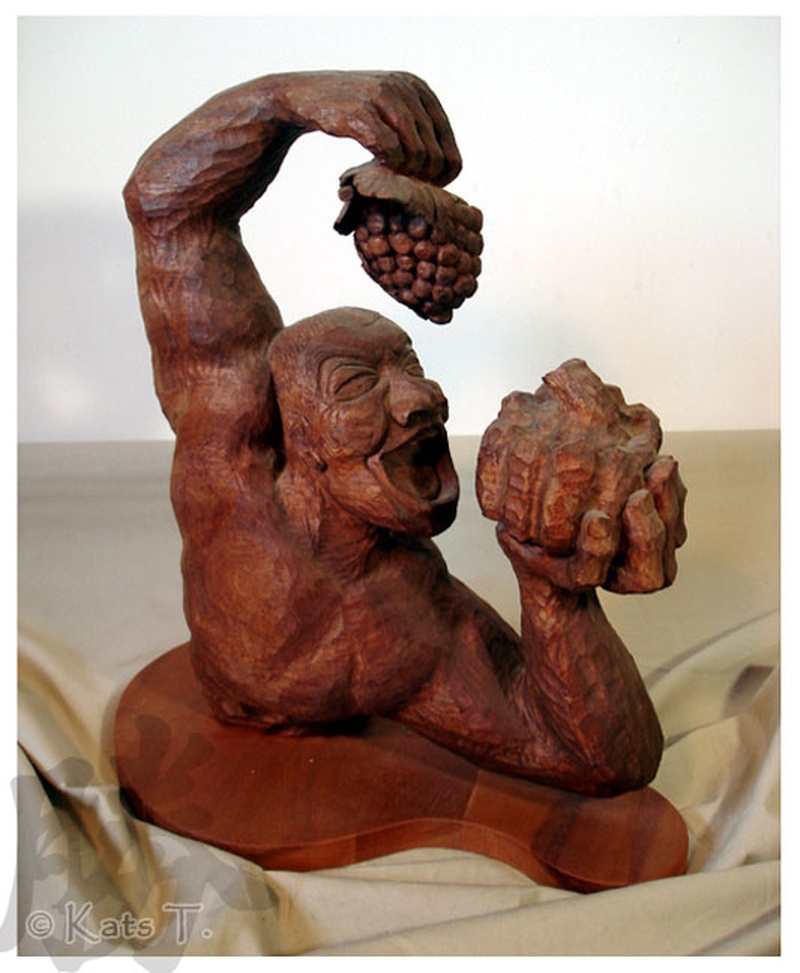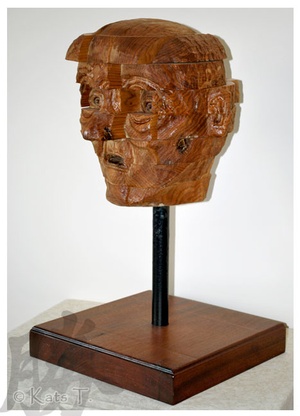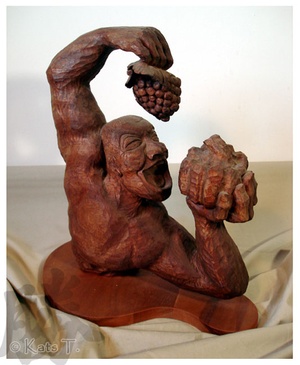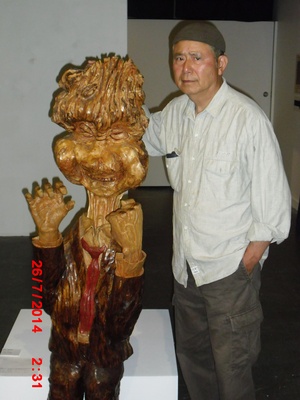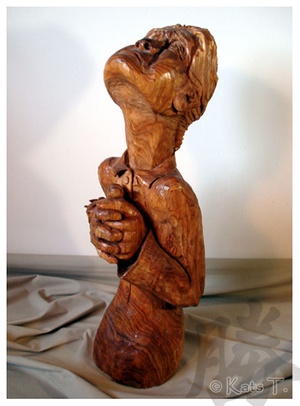Read Part 1 >>
Title: “Cancer Notice” (butternut wood)
Having retired only recently after working a long time, I was very excited. I could now do all the things I dreamed of doing, with all the time in the world to do it. That excitement turned to bitter disappointment though, when the doctor gave me the news.
As I lay bored in the hospital bed, I couldn't help but wonder if there was some way that I could carve the feeling of shock I felt at that time. I used screws to set the wood to just the right size as my face, and as I carved more and more pieces of my face into it, I would take those pieces off one by one, shift them like puzzle pieces, and use glue to set them until I was done.
I think of all my carvings, this is the one that most honestly reflects my feelings at the time.
(Original transcription in Japanese)
定年まで働いて退職した。私はなにかウキウキしていた。そんな私も医者の「癌ですね」のひと言にすっかり参ってしまった。
病院のベッドでたいくつになった私は、医者に「癌ですね」と言われた時のあの驚きをなんとか木彫りで表せないか?そればかり考えていた。2x2をスクリューでとめて顔の大きさに作り、顔を彫ってからスクリューをはずし、一本、一本づらしてグルーでとめて出来上がり。
私の作品の中で最も気持ちを表せた作品である。
Title: “Sunday Farmer” (1985, mahogany)
I remember telling my eldest brother: "if either of our parents die, I can't come to the funeral anyway so let me know after they're gone." One day, he called to tell me my mother had died the night before; this was just as I was struggling to come up with the farmer's face for this carving.
The pumpkin was in the way and I was having trouble getting the face right; just as I was thinking "this damn pumpkin!" I put a little too much force into it and the wrist holding the pumpkin broke. My mother was mad at me - this thought immediately came to my mind, since I hadn't really had time to deal with my feelings of loss.
The next day, as I glanced at the broken carving, I saw for the first time how the face should look; it was all thanks to the pumpkin not being there anymore. The technique of breaking off an outside part in order to "see" what the inside should look like, then attaching the outside part again later is something I also used for "Mother and Child" for the thumb part.
I wonder if my mother is still mad at me. It's not a great carving, but it's a work that comes from a great memory.
(Original transcription in Japanese)
両親どちらが死んでも葬式には帰えらん。知らせは死んでからにしてくれ。と言う俺の願いを長兄はまもって 、「夕べお袋が死んだ」との電話があったのは、俺がfarmerの顔を彫るのに苦心していた時だ。
南瓜が邪魔で顔が上手く彫れない。じゃまなカボチャめと力を入れる。途端に南瓜が乗っている手首がポキリと折れた。「お袋が怒っている。」それまで、気持を集中出来なかった俺は本当にそう思った。次の日、ぼんやりと転がっている彫り物を見ていた俺は、南瓜がないため丸出しの顔が良く見えた。外側が邪魔で中が彫りずらい時は、外側をへし折って中を彫ってから外側を貼り付ける、というテクニックは、Mother & child の親指にも使われている。
お袋 まだ怒っているかな。良い彫り物ではないが、良い思いでの作品だ。
Title: “Oh Girl!” (2000, basswood)
When I was young, an old Japanese man shared his thoughts with me:
“There is nothing more frustrating than a woman. You praise her a little, and it goes to her head. You warn her about this, and she gets annoyed. You get mad at her, and she cries. You can’t kill her, because she’ll come back to haunt you.” I guess he was right: there is nothing more frustrating than a woman.
(Original transcription in Japanese)
私が まだ少年だった頃 私の村の物知りの老人が私に教えてくれたこと。
女ほど 始末の悪いものはない。ちょっとほめると すぐにつけ上がる しその事を注意したら すぐに 膨れるし殴りゃ泣くし 殺せば 化けて出る 本当に 女ほど始末の悪いものはない。
Title: “Mad Steve” (willow, head; catalpa, body)
My father-in-law had Alzheimer’s Disease. As a result of this, I made two or three works; this is one of them. When he looked at our faces, he would say “I know you are just waiting for me to die.” He would say this over and over again, so I once lost my patience and said, “Yeah that’s right, we are.” Boy, did he ever get mad.
(Original transcription in Japanese)
私の義父はアルツハイマー病でした。言っちゃ悪いが、こうゆう人の方が私には興味がある。で、2、3、義父をモデルにして彫った。これはそのひとつ。
私達が会いに行くと、私達の顔をジロリと見て「お前さん達は、ワシの死ぬのを待っているんだろう」と言う。その度に私と妻は、「そんなことを言うものではない」と言っていたが、ある日、あまりのしつこさに私は、「Yeah that's right can't wait any longer. (あぁ、これ以上もう待てないね)」と言ってしまいました。親父さんの怒ったこと、怒ったこと。
Title: “Please, Catalpa”
I’m not a very religious person. It’s not to say I’m not spiritual, it’s just that I’m not interested in religion.
Whether it’s Christ, the Buddha, Mohammad, or otherwise, I AM interested in these men who founded their respective religions but I think they would all grimace if they were to see the state of their teachings now in the present.
The other day I went to the funeral of an acquaintance. There, I saw an old man praying for so long, with such intensity, that I thought he would cry. I don’t know why, but I started to feel embarrassed and so I silently bowed to the old man.
(Original transcription in Japanese)
私は神仏をあまり信じないほうだ。信じないというより、関心が無い。が、キリストなり、お釈迦様なり、モハメッドなり それぞれの宗教を起こした男達への関心はある。男達はそれぞれの宗教が持っている。今の問題に しかめっ面をするかもしれない。
先日知人の葬式に行った。 そこで 一心に祈っている老人を見た。長いこと泣きそうな顔で祈っていた。私はなぜか恥ずかしくなり、そっとその老人にお辞儀をした。
Title: “It’s Coming” (2012, Silver Maple)
I got the material for this piece at a place that I call the “tree dump.” When I asked the person working there what kind of wood it was, he told me he thought it was a silver maple.
When I think about it, I wonder why this wood caught my eye; the inside was mostly rotten and even when I cleaned the outside, I had doubts as to what I could use it for. It’s simply that bad.
I had left it for about five years, but as my condition got worse, I thought it would serve as a good way of showing the fear I felt and I started using it.
At first I thought I would raise one of the legs to make it a dynamic pose, but then I decided that as a way to show the hope that my condition slows down, I put both of his feet on the ground.
(Original transcription in Japanese)
この材料は市のtree dump(と、私は呼んでいる)場所へ行って拾ってきたものです。働いている人に聞いてみると Silver mapleだそうで、今思うと、何でこんなものを?と思います。何しろ中身がほとんど腐っていて、皮をはいできれいに洗ったら何に使える?というほどの物です。
5年ほど乾燥させておいたものを、今度の病気がだんだんと悪くなってくる恐怖を表せたらと思い彫りました。始めは片足を上げてダイナミックにするつもりだったが、もっとゆっくりと来るようにと言う願いをこめて、フラットな両足にしました。
For more information check out Kats’ website at takadakats.livejournal.com.
© 2014 Norm Ibuki


